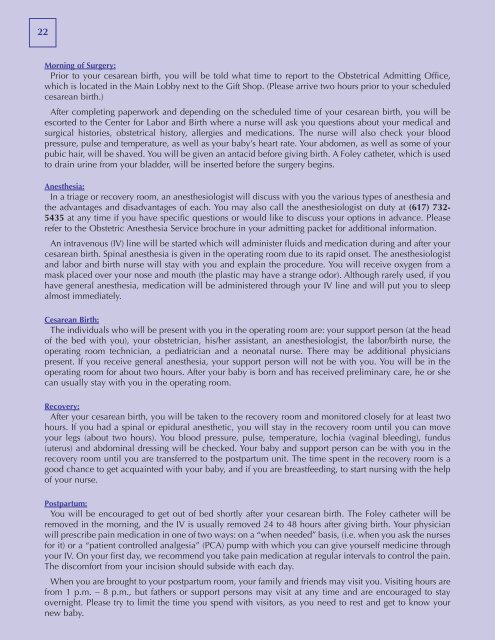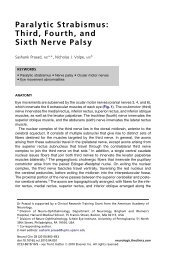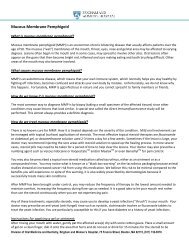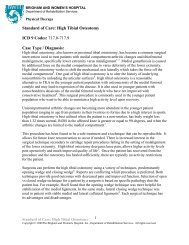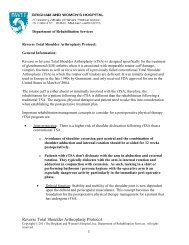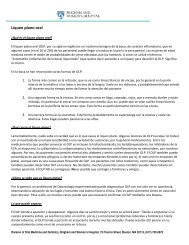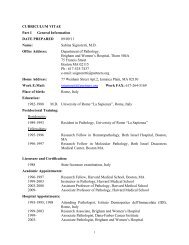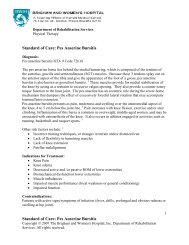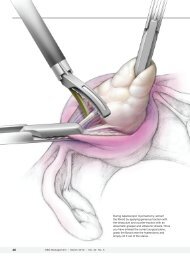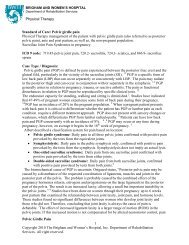Enjoying Your Pregnancy Guide to Understanding - Brigham and ...
Enjoying Your Pregnancy Guide to Understanding - Brigham and ...
Enjoying Your Pregnancy Guide to Understanding - Brigham and ...
You also want an ePaper? Increase the reach of your titles
YUMPU automatically turns print PDFs into web optimized ePapers that Google loves.
22<br />
Morning of Surgery:<br />
Prior <strong>to</strong> your cesarean birth, you will be <strong>to</strong>ld what time <strong>to</strong> report <strong>to</strong> the Obstetrical Admitting Office,<br />
which is located in the Main Lobby next <strong>to</strong> the Gift Shop. (Please arrive two hours prior <strong>to</strong> your scheduled<br />
cesarean birth.)<br />
After completing paperwork <strong>and</strong> depending on the scheduled time of your cesarean birth, you will be<br />
escorted <strong>to</strong> the Center for Labor <strong>and</strong> Birth where a nurse will ask you questions about your medical <strong>and</strong><br />
surgical his<strong>to</strong>ries, obstetrical his<strong>to</strong>ry, allergies <strong>and</strong> medications. The nurse will also check your blood<br />
pressure, pulse <strong>and</strong> temperature, as well as your baby’s heart rate. <strong>Your</strong> abdomen, as well as some of your<br />
pubic hair, will be shaved. You will be given an antacid before giving birth. A Foley catheter, which is used<br />
<strong>to</strong> drain urine from your bladder, will be inserted before the surgery begins.<br />
Anesthesia:<br />
In a triage or recovery room, an anesthesiologist will discuss with you the various types of anesthesia <strong>and</strong><br />
the advantages <strong>and</strong> disadvantages of each. You may also call the anesthesiologist on duty at (617) 732-<br />
5435 at any time if you have specific questions or would like <strong>to</strong> discuss your options in advance. Please<br />
refer <strong>to</strong> the Obstetric Anesthesia Service brochure in your admitting packet for additional information.<br />
An intravenous (IV) line will be started which will administer fluids <strong>and</strong> medication during <strong>and</strong> after your<br />
cesarean birth. Spinal anesthesia is given in the operating room due <strong>to</strong> its rapid onset. The anesthesiologist<br />
<strong>and</strong> labor <strong>and</strong> birth nurse will stay with you <strong>and</strong> explain the procedure. You will receive oxygen from a<br />
mask placed over your nose <strong>and</strong> mouth (the plastic may have a strange odor). Although rarely used, if you<br />
have general anesthesia, medication will be administered through your IV line <strong>and</strong> will put you <strong>to</strong> sleep<br />
almost immediately.<br />
Cesarean Birth:<br />
The individuals who will be present with you in the operating room are: your support person (at the head<br />
of the bed with you), your obstetrician, his/her assistant, an anesthesiologist, the labor/birth nurse, the<br />
operating room technician, a pediatrician <strong>and</strong> a neonatal nurse. There may be additional physicians<br />
present. If you receive general anesthesia, your support person will not be with you. You will be in the<br />
operating room for about two hours. After your baby is born <strong>and</strong> has received preliminary care, he or she<br />
can usually stay with you in the operating room.<br />
Recovery:<br />
After your cesarean birth, you will be taken <strong>to</strong> the recovery room <strong>and</strong> moni<strong>to</strong>red closely for at least two<br />
hours. If you had a spinal or epidural anesthetic, you will stay in the recovery room until you can move<br />
your legs (about two hours). You blood pressure, pulse, temperature, lochia (vaginal bleeding), fundus<br />
(uterus) <strong>and</strong> abdominal dressing will be checked. <strong>Your</strong> baby <strong>and</strong> support person can be with you in the<br />
recovery room until you are transferred <strong>to</strong> the postpartum unit. The time spent in the recovery room is a<br />
good chance <strong>to</strong> get acquainted with your baby, <strong>and</strong> if you are breastfeeding, <strong>to</strong> start nursing with the help<br />
of your nurse.<br />
Postpartum:<br />
You will be encouraged <strong>to</strong> get out of bed shortly after your cesarean birth. The Foley catheter will be<br />
removed in the morning, <strong>and</strong> the IV is usually removed 24 <strong>to</strong> 48 hours after giving birth. <strong>Your</strong> physician<br />
will prescribe pain medication in one of two ways: on a “when needed” basis, (i.e. when you ask the nurses<br />
for it) or a “patient controlled analgesia” (PCA) pump with which you can give yourself medicine through<br />
your IV. On your first day, we recommend you take pain medication at regular intervals <strong>to</strong> control the pain.<br />
The discomfort from your incision should subside with each day.<br />
When you are brought <strong>to</strong> your postpartum room, your family <strong>and</strong> friends may visit you. Visiting hours are<br />
from 1 p.m. – 8 p.m., but fathers or support persons may visit at any time <strong>and</strong> are encouraged <strong>to</strong> stay<br />
overnight. Please try <strong>to</strong> limit the time you spend with visi<strong>to</strong>rs, as you need <strong>to</strong> rest <strong>and</strong> get <strong>to</strong> know your<br />
new baby.


